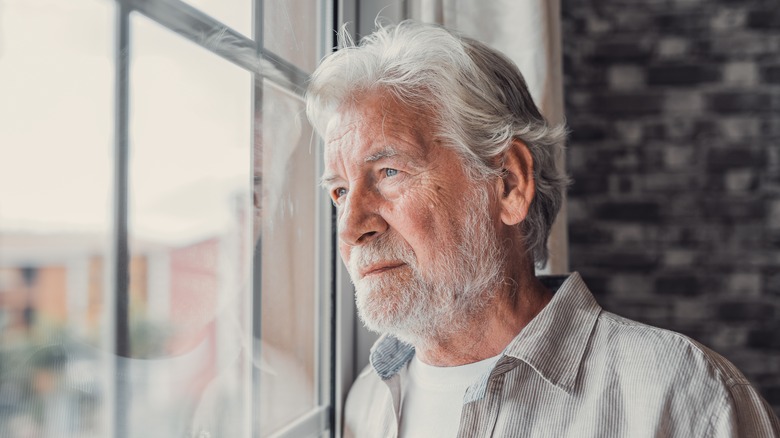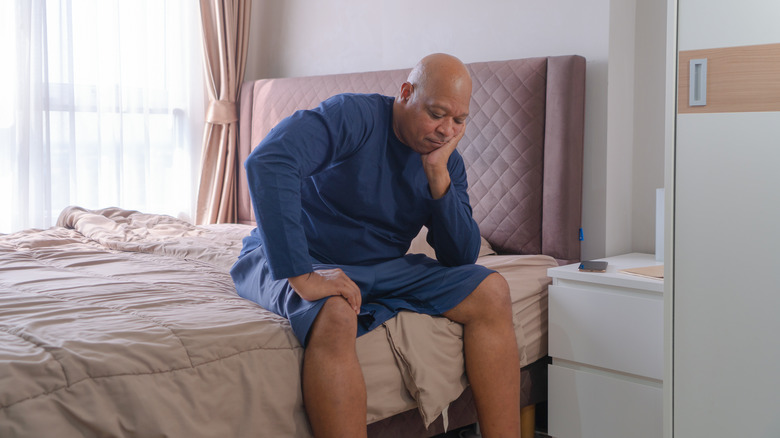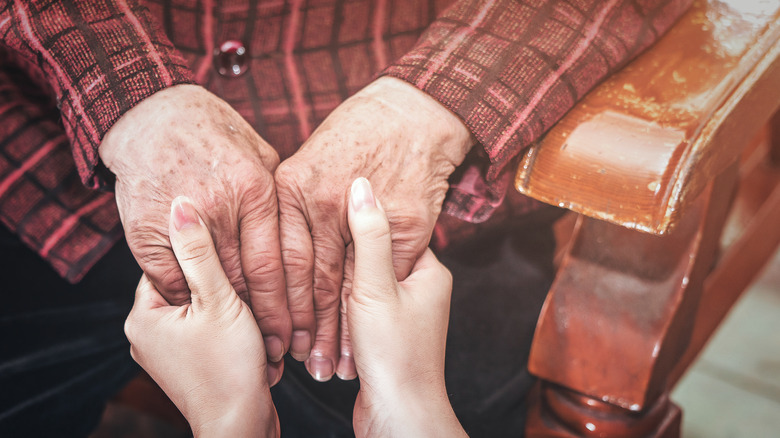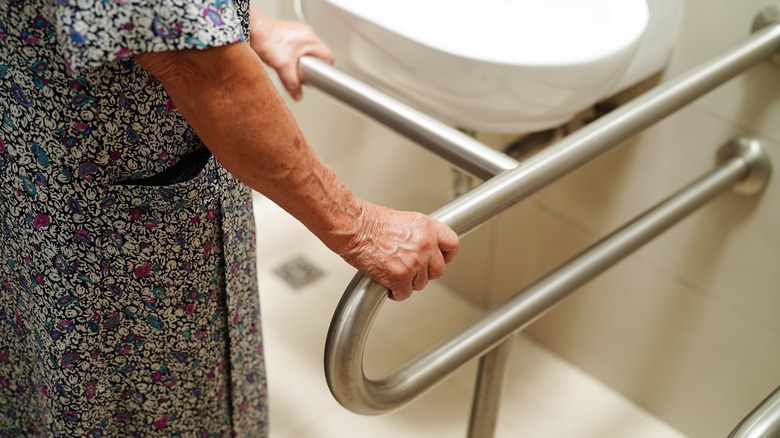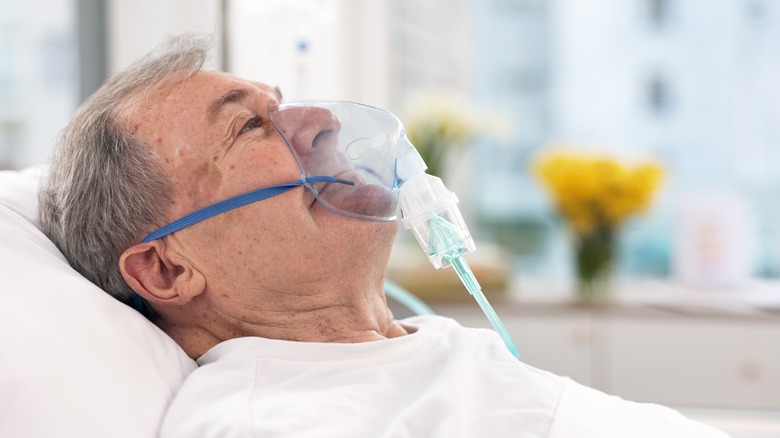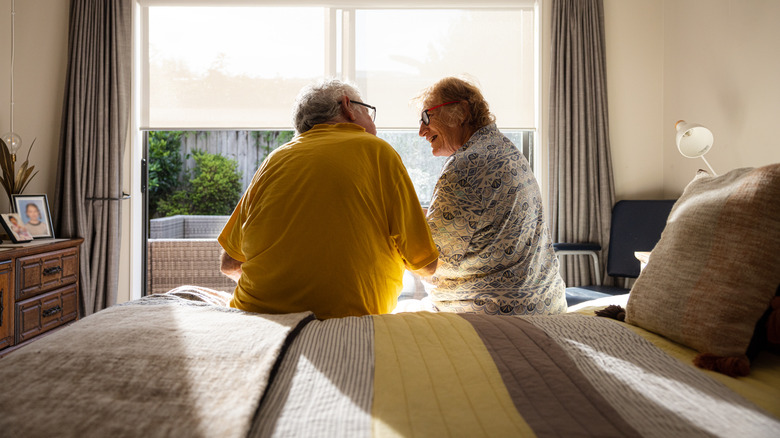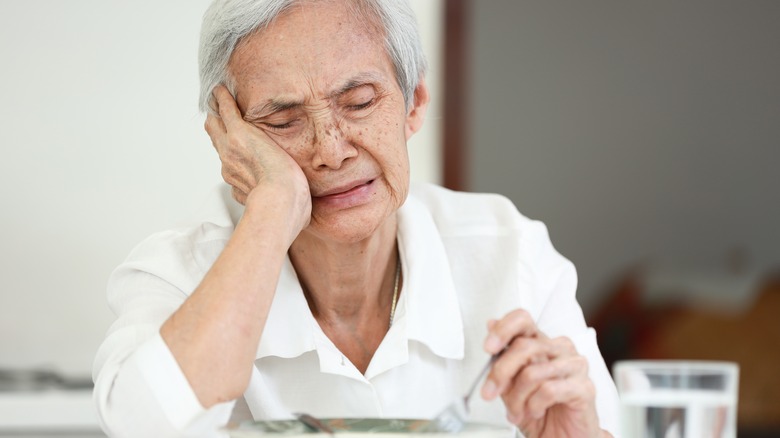Strange Things That Happen To The Body At The End Of Life
As the end of one's life approaches, the body begins to go through a number of changes as it starts to shut down (via Healthdirect). In general, the body's normal operations tend to function more slowly, which can create a domino effect throughout the body. So, if the heartbeat begins to slow down, that impacts the circulation of blood and oxygen throughout the body, which can affect the way other organs, such as the brain, function.
During this process, loved ones of a person at the end of his or her life may notice some unusual symptoms and behaviors, according to My Health Alberta. A person may become restless, confused, and agitated. They may experience muscle twitches and spasms or an irregular heartbeat. All of these things are normal and an expected part of the dying process. The important thing is not to be thrown off or overly concerned by these behaviors, and instead focus on making your loved one as comfortable as possible.
Terminal restlessness
Terminal restlessness is a condition that can occur in people who are reaching the end of life, and is marked by a number of different symptoms, including agitation, confusion, and emotional outbursts (via Healthline). During these times, a person suffering from terminal restlessness might try and pull off their clothes, yank out intravenous tubes, or provoke arguments and fights with their loved ones or caretakers. There is no one thing that anyone can point to as being the cause of terminal restlessness, however. Although certain things like chemotherapy and opioids can be triggers, most of the symptoms can be attributed to the physical and mental changes the body undergoes at the end of life.
According to Marie Curie, treating a patient who is suffering from terminal agitation starts with attempting to identify what could be causing it. It could be that they are starting a new medication or that a change in their treatment may have occurred. Asking questions about their condition and helping them to try and verbalize what they are feeling can also help determine the root of their restlessness. In addition, simple things like placing a clock in the room can help ground the patient and make them feel a little more in control of their environment.
Dropping body temperature
At the end of life, as the body begins to shut down, one noticeable sign is a steady drop in body temperature. According to Suncrest Hospice, the temperature drop is caused by a change in metabolism and is fairly common in elderly people, who often wear warmer clothes even when it is hot outside. However, as a person grows closer to death, the temperature change can become much more drastic, making a person feel cold to the touch, and their skin may look thin and almost purple in color.
The Hospice Foundation of America notes that a dying person's body temperature can change by one degree or more towards the end of their life. However, it's not advisable to try to warm them up with heating pads. A person's skin at this stage of life is very thin, and a heating pad or similar device could cause burns. Something like a warm blanket can help stave off the cold while also hopefully providing a small amount of comfort.
Changes in skin tone
Mottled skin, in which blue or purple patches appear on the surface, is a fairly common occurrence towards the end of life (via Crossroads Hospice). A primary cause is the heart's inability to properly pump blood any longer. It tends to crop up during the last week of life and is usually a sign that death is imminent. That said, mottled skin doesn't always occur before death, and individual cases can vary.
According to Serenity Hospice Care, the condition is also known as livedo reticularis, and is an indication that the body's circulatory system is beginning to slow down. It tends to appear first on the feet or legs, but can also be seen on hands and arms as well. It's a good idea to speak with the doctor who is caring for your loved one to determine the cause of the mottling and what it could mean.
A surge of energy
Shortly before dying, a person may experience a sudden burst of energy and lucidity. As explained by Ruby Gramlow, RN, CHPN of Hospice Red River Valley, this period can be marked by an increased appetite, coherent communication, and even restlessness and mobility. In some cases, this surge can lull a patient's loved ones into believing that he or she is getting better and may even be making a full recovery.
According to GoodRx Health, four out of ten people will experience this burst of energy, sometimes called an "end of life rally" or "terminal lucidity," prior to death. When it happens, the patient is usually alert, calm, and focused. This can create confusion for loved ones, but experts agree that it should be seen as a time for last goodbyes and final words of love and comfort instead of a sign that things are turning around. However, as not everyone experiences an end-of-life rally, it's also important to practice self-care in order for people to be able to be there for their loved ones at the end.
Changes in bowel and bladder function
Changes in bowel and bladder function are an unfortunate byproduct of a person nearing the end of his or her life. According to Quest Healthcare, 18% of patients receiving palliative care can suffer with changes in bowel habits. By the time a patient comes close to death, that number can rise to as high as 80%. However, in the case of constipation, according to a 2012 study published in the Journal of Pain and Symptom Management, up to 90% of palliative care patients can be affected.
My Health Alberta reports that patients at the end of life may urinate less. And, when they do urinate, that urine will be darker in color, shades of brown or red. Additionally, it may be harder for the patient to have bowel movements due to reduced fluid consumption. In those cases, it may be necessary to introduce laxatives or, in extreme cases, even attempt an enema in order to make the passing of stool easier and more comfortable for the patient.
Changes in breathing patterns
As the end of life approaches and the body begins the process of shutting down, it's very common for a patient's breathing patterns to be affected (via The Connecticut Hospice). One of the most common breathing patterns seen at the end of life is known as Cheyne-Stokes breathing. This is marked by deep breathing, followed by shallower and shallower breaths and even pauses in breathing entirely. While it can be alarming for a patient's loved ones, Cheyne-Stokes breathing is usually painless for the patient themselves.
Another breathing change that can occur as the end of life approaches is known as agonal breathing (via HPC Consultation Services). When this happens, breathing becomes an involuntary act, and one's breathing can be marked by what may sound like grunts or gasps as air is forced through a patient's now-relaxed vocal cords. While this can give one the impression that a dying person is gasping for air, in reality it is merely the respiratory system working on reflex.
Hallucinations and delirium
Hallucinations and visions are more common before death than one might think, according to Crossroads Hospice & Palliative Care. Caregivers have reported end-of-life patients seeing people who aren't there, talking to loved ones who have passed away, and smelling scents, such as cigars or perfume, that only they can smell. They may also become agitated by these visions, perhaps tracing them back to past actions or people they have wronged. For caregivers and loved ones dealing with a patient who is experiencing these visions, experts maintain that it is important to not try and prove or disprove the visions, but to try and be sensitive and understanding of what the patient is experiencing.
According to a 2016 study published in the Indian Journal of Palliative Care, more than 60% of patients profiled experienced dreams and visions at the end of life. Of those, 78% reported seeing people who had died before them, including friends and relatives. More than 80% said that they were initially distressed by these visions, but ultimately felt better about them after discussing them with the study team.
Sleeping more
As a person is dying, their metabolism slows down, which can lead to feelings of tiredness and fatigue. As a result, they may sleep more and more during the day. Registered nurse Barbara Karnes says that excessive sleep is a natural part of the body shutting down, likening the body to a battery that is losing its charge. While sleep can provide a dying patient with a little bit of energy, eventually they will simply no longer need the charge provided by sleep or be awake for extended periods of time.
According to Healthline, part of the reason for a dying person sleeping less is a decrease in metabolism. As the body's metabolism breaks down, it becomes harder to keep one's energy up. When that happens, keeping fatigue at bay can be a difficult task. The best thing a loved one can do in these instances is to let the patient sleep as much as they need to, ensuring that they get up when they can and stay mobile to avoid developing bedsores.
Decreased food and water intake
There are a number of reasons why, at the end of life, a person may begin to lose his or her appetite. According to Cancer Research UK, an unwillingness to eat or drink can be caused by pain, difficulty breathing, or tiredness. Additionally, as one's body begins to go through the process of shutting down, it becomes more difficult to digest food. As a result, eating can make one feel nauseous or cause such symptoms as diarrhea. As a result, it can be understandable that an end-of-life patient may be somewhat resistant to eating.
If you or a loved one is facing an end-of-life situation and struggling with issues around appetite, you can talk to your doctor about how best to manage it (via Pancreatic Cancer UK). You or your loved one should feel comfortable eating as much or as little as they can manage. If you're feeling ill, you can also take a break and return to eating later. In addition, switching to softer, easier-to-manage foods like ice cream and yogurt might be a good alternative and help keep your appetite up.
